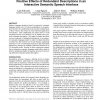Free Online Productivity Tools
i2Speak
i2Symbol
i2OCR
iTex2Img
iWeb2Print
iWeb2Shot
i2Type
iPdf2Split
iPdf2Merge
i2Bopomofo
i2Arabic
i2Style
i2Image
i2PDF
iLatex2Rtf
Sci2ools
IUI
2009
ACM
2009
ACM
Positive effects of redundant descriptions in an interactive semantic speech interface
Spoken language interfaces based on interactive semantic language models [16, 14] allow probabilities for hypothesized words to be conditioned on the semantic interpretation of these words in the context of some interfaced application environment. This conditioning may allow users to avoid recognition errors in an intuitive way, by adding extra, possibly redundant description. This paper evaluates the effect on error reduction of redundant descriptions in an interactive semantic language model. In order to evaluate the effect in natural use, the model is run on rich domains, supporting references to sets of individuals (instead of just individuals themselves) arranged in multiple continuous dimensions (a 2-D floorplan scene). Results of these experiments suggest that an interactive semantic language model allows users to achieve significantly higher recognition accuracy by providing additional redundant spoken description.
Interactive Semantic Language | IUI 2009 | Semantic Language Model | Semantic Language Models | Software Engineering |
| Added | 17 Mar 2010 |
| Updated | 17 Mar 2010 |
| Type | Conference |
| Year | 2009 |
| Where | IUI |
| Authors | Lane Schwartz, Luan Nguyen, Andrew Exley, William Schuler |
Comments (0)

